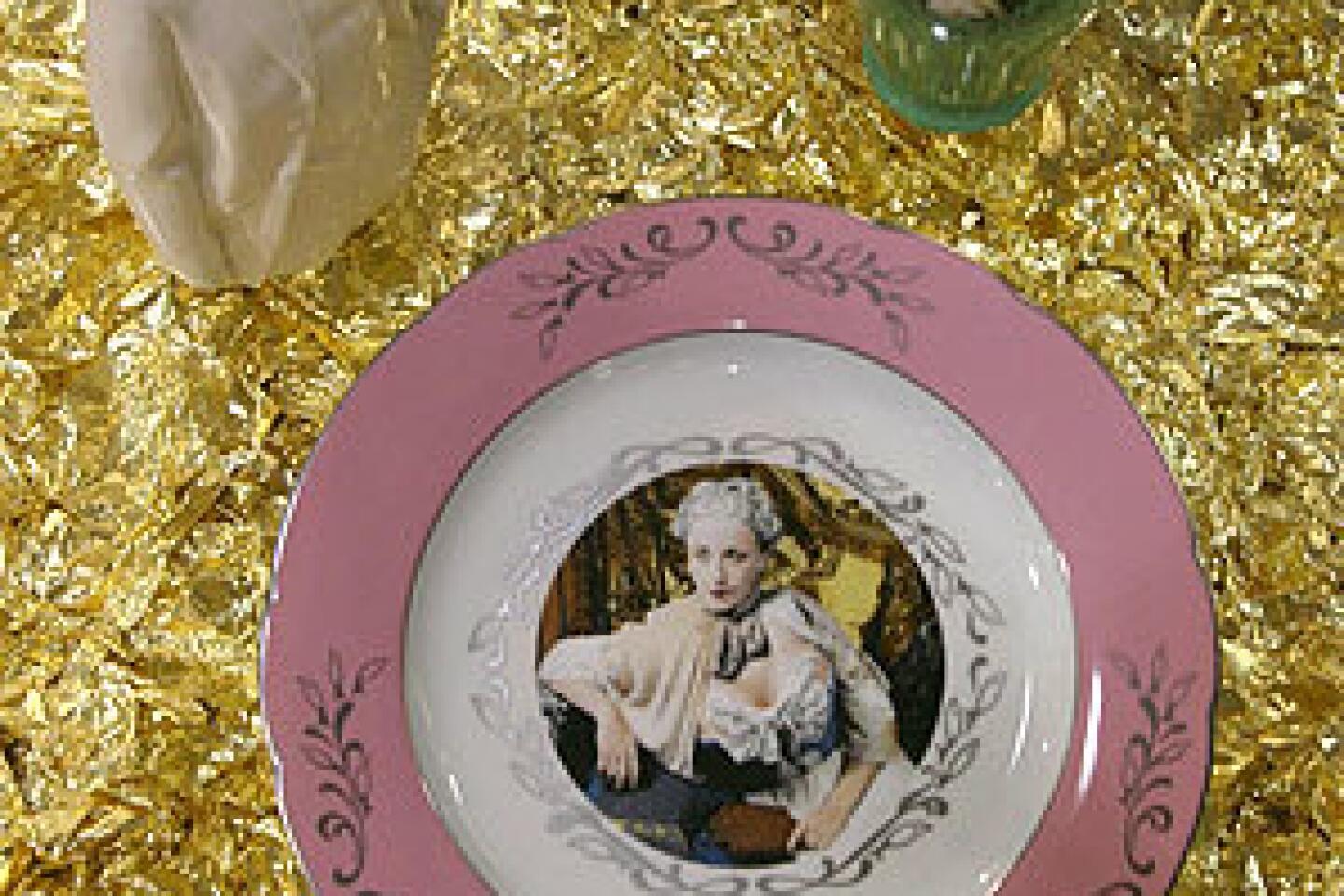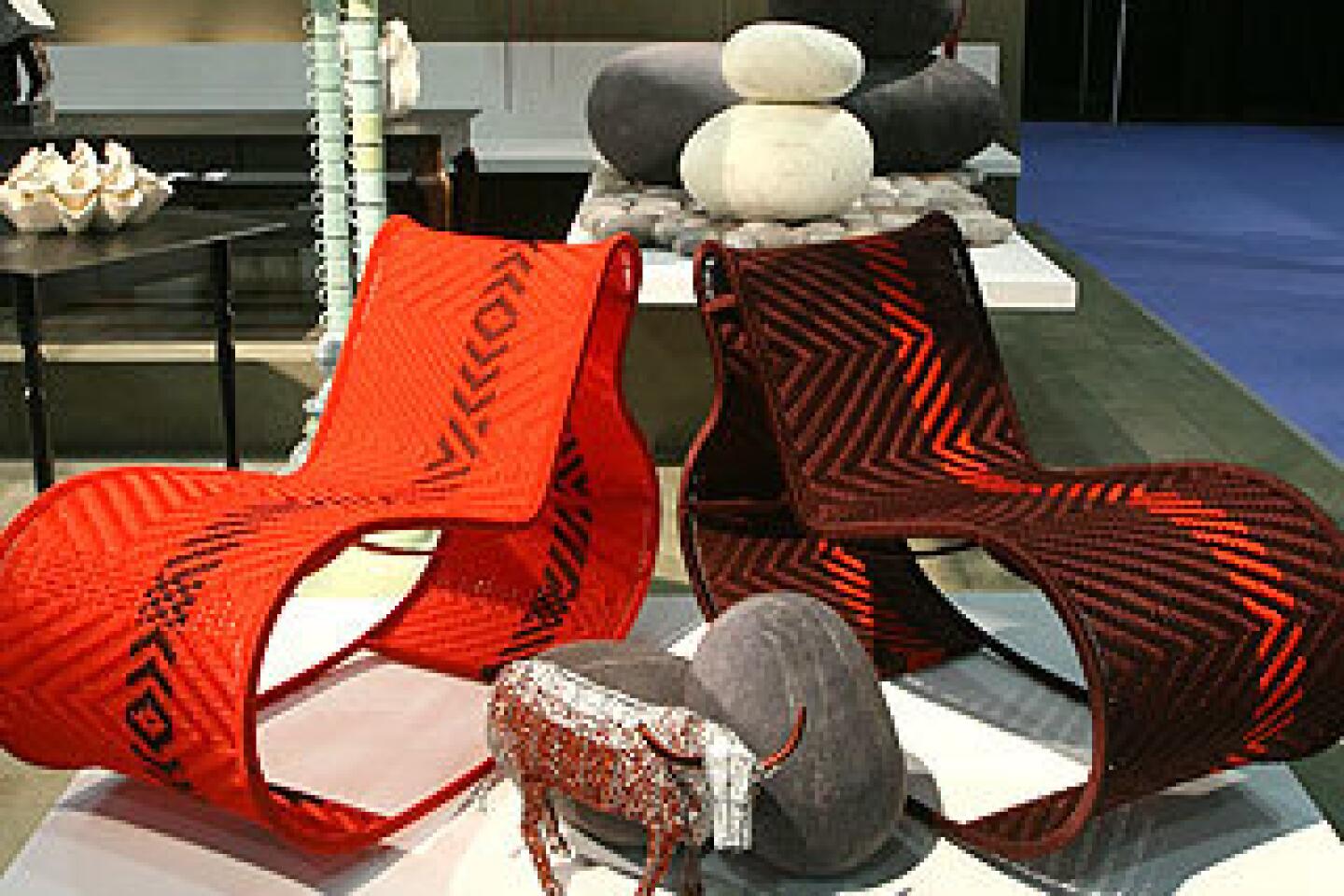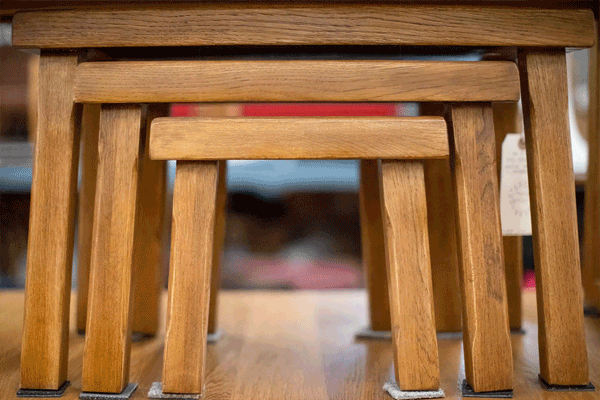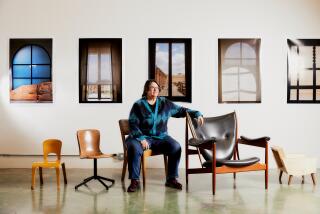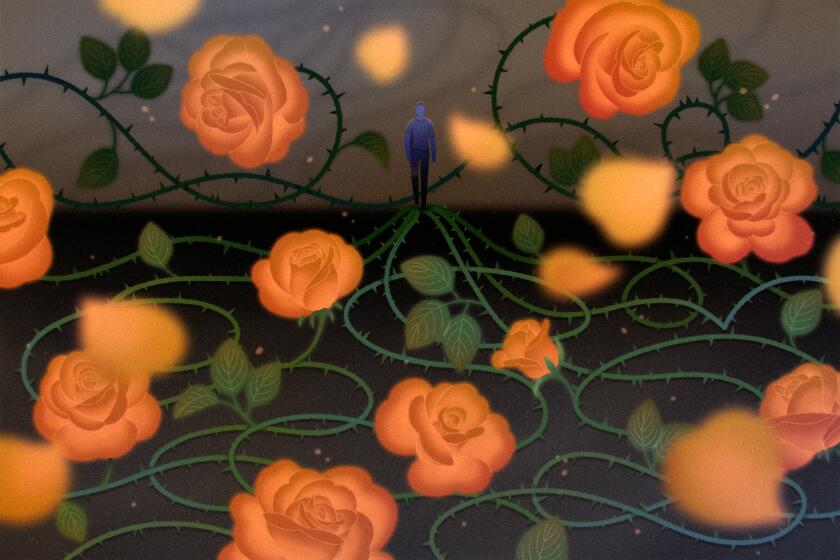A fresh journey for familiar forms
New York — DIPPED in a garish green rubbery coating, the ornate Louis-style dining chairs from Six Inch of Belgium looked like irradiated doggy chew toys. The white fiberglass centipede reared on its legs was really Scolopendra, a 7-foot floor lamp made by Site Specific Design in Brooklyn.
And the beanpole clad in fluorescent pink? That was designer Karim Rashid, the prolific creator of household “blobjects,” stalking the aisles of the 19th annual International Contemporary Furniture Fair, which ended its four-day run here Tuesday.
Arguably the country’s most important showcase of forward-thinking design, the fair drew an estimated 25,000 architects, decorators and retailers. Nearly 350 exhibitors showed new furniture and accessories from more than 30 countries.
Though the global design community had seen the latest styles at earlier shows such as 100% Design in London, Maison et Objet in Paris and the Milan furniture fair, ICFF is where most North Americans view European product introductions and is the principal place for many U.S. firms to unveil new lines.
Among them: more than two dozen from California, including a collective known as Left Edge, which filled a pavilion with sleek teak pieces, contemporary tables with stainless steel accents, Modernist children’s furniture and hand-loomed textiles.
Grant Seltzer, owner of L.A.’s Jules Seltzer showroom for midcentury classics, sat on San Francisco designer Rick Lee’s minimalist sofa, whose wool covering spilled onto the floor to form an area rug. Seltzer smiled at Lee’s puddle-inspired metal pedestal tables and a golden clothing rod shaped like a woman’s arm, with hands for finials.
“Designers are really thinking again,” Seltzer said. “They are using new and recycled materials to create whimsical and sophisticated products.”
Josh Urso was one of those attempting to make familiar objects look fresh. The 29-year-old from New Jersey used resin-reinforced mesh fabric to create lightweight chairs. He also used similarly fortified coils of rope to make table bases and lighting fixtures.
By contrast, Ted Nemeth Designs reimagined Old World tables and highboy dressers as pieces sheathed in biker-chic leather with brass knuckles and bottle openers as hardware and drawer pulls.
This experimentation with traditional European forms that has been popular for a few seasons continued unabated at the show. British designer John Reeves’ tables sprouted heavily lathed-carved or harp-shaped legs cut into quarters, which then were mounted so the clean lines of a parsons table faced outside and the ornamental edge was tucked within.
The design collective 2 by Amuneal advanced that look with a table that had yellow turned legs and a rich brown top that integrated the work of Barcelona-based street artists. Surrounding it were upholstered 18th century oval-backed dining chairs with photo-printed fabrics. A cherry red Louis-style armchair had a riveted aluminum seat, and a vivid yellow floor lamp had an enormous shade that read “Turn Me On Turn Me Off” when illuminated.
“It is a collision of art and fashion, the antique and the industrial,” Brooklyn-based designer Gilberto Santana said.
If some designs tended toward trendy, others were intentionally arty. Artware offered “artist multiples,” furniture and accessories designed by painters such as Yves Klein, who created glass tables filled with blue powdered pigment and gold leaf foil, and photographer Cindy Sherman, who put her bewigged mug on a Rococo-style teapot.
Another strong trend was the continued pull of early 20th century Modernism and midcentury Scandinavian and American design. Gratz Industries, the original manufacturer of Mies van der Rohe’s Barcelona furniture, showed the architect’s 1930 Tugendhat chair alongside new editions of archival designs, including William Katavolos’ 1952 stainless steel and leather sling chair.
The Danish pavilion was dotted with the work of Hans Wegner and Arne Jacobsen, all illuminated by new lighting fixtures by Refer + Staer. The Herman Miller booth had a stainless steel version of the Eames 670 lounge chair and ottoman by Laguna Beach sculptor Cheryl Ekstrom, and the Cherner Chair Co. added children’s tables and seats to its line of bent plywood furniture.
To witness just how global the design community has become, one need look no further than this show. A coalition of Belgian and Austrian designers showcased wry minimalist furniture, and the Lithuanian group Contraforma displayed chairs with 10 legs on felt jigsaw puzzle rugs.
Two Turkish firms made impressive statements: Autoban had vase-shaped lamps and side tables made from brass wire that will be carried in the Los Angeles store De La Espada, and the tabletop firm Gaia & Gino paired with the California College of the Arts to design a canine accessories line called Gino the Dog.
For Hollywood regency devotees, 30-year-old Tokyo designer Yuki Tanaka of Waazwiz crafted flawless Lucite furniture, including the Glacial Sofa, a faceted throne upholstered in shaggy lambswool that will sell for about $16,000 in the United States.
FURNITURE that looks like cut gems is, indeed, a growing trend but has a counterpoint: a hunger for rusticity.
The simplicity of tribal forms and patterns in the Cameroonian stools at Tucker Robbins, and the woven Mali chairs by Amaridian were eye-catching. Nakashima-influenced pieces included huge slabs of timber presented on minimalist bases by SMC Furnishings, and hollowed-out tree trunks fashioned into lighting pendants by Brent Comber of North Vancouver, B.C.
For a giggle, the Canadian firm Thout Design paired a red maple table with powder-blue log stools that had a hole for stashing a beer, and the Pennsylvania firm Fleetwood Fixtures offered Timber, a fiberglass tree stump in four colors that serves as a table or seat. Other designers also embraced the tree-hugger within, and if this show is any indication, “reduce, reuse and recycle” may be as defining a statement for our times as “form follows function” was for 20th century Modernism.
Many designers are turning green in terms of the materials they use (organic fabrics, reclaimed and sustainable woods, water-based finishes) as well as the way they manufacture and ship.
Bamboo plywood was introduced as an option on Richard Schultz’s classic daisy-shaped Petal table. Recycled glass appeared in drinking glasses and mosaic tiles, and the Portland, Oreart glass collective Esque turned brown and green beer bottles into wishbone and skull figurines — “twin symbols of hope and doom,” partner Andi Kovel says.
Esque also participated in Haute Green, an exhibition timed this year with ICFF and held in a Manhattan gallery space. Among the highlights: Eggflat, a bowl made from pressed wool felt that originated as lint from fabric mills, and the RD4 chair, a sculptural piece woven from strips of plastic packaging.
Although some designs showed style and substance, not all of the products were winners. Larry Schaffer, owner of the L.A. store OK, encountered pieces that tried too hard. “That’s great for all the décor websites and blogs because they need new stuff every 20 minutes,” he says. “But I want to buy an object that’s going to improve my life and that I will still be happy to live with in 20 years.”
david.keeps@latimes.com
More to Read
Sign up for The Wild
We’ll help you find the best places to hike, bike and run, as well as the perfect silent spots for meditation and yoga.
You may occasionally receive promotional content from the Los Angeles Times.

